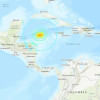Two tremors near Dhaka raise concern
Two earthquakes with epicentres very close to Dhaka jolted the capital in a span of just 11 days, raising concerns among leading experts about more quakes and the country's preparedness.
A 4.3 magnitude earthquake struck Dhaka and some other parts of the country early yesterday. Its epicentre was in Dohar upazila, some 30 kilometres away from the capital, according to the Bangladesh Meteorological Department.
Another 3.9 magnitude earthquake, the epicentre of which was in Bhulta of Narayanganj, about 24 kilometres away from the capital, hit Dhaka on April 25.
A total of 14 earthquakes took place within the 300 km radius of Dhaka in the last one month, says the National Center for Seismology of India.
Experts say these jolts are possible indications of a major earthquake which has not been reported in the country for a long time.
"Our research showed that over 8-magnitude earthquake energy was accumulated in the plates in Bangladesh territory over the years and the energy can get released anytime. The recent earthquakes give indications of it," Syed Humayun Akhter, a former professor of geology at Dhaka University, told The Daily Star yesterday.
A 5.2 magnitude earthquake jolted Dhaka and several other parts of the country on December 5 last year. The epicentre of the quake was 520 km away from the Agargaon Seismic Centre in Dhaka.
Two major earthquake fault lines in the country are Madhupur Fault and Dauki Fault. The Madhupur fault line in Tangail is closer to Dhaka, while the Dauki fault line is in Sylhet.
Prof Mehedi Ahmed Ansary, a teacher at the Buet's civil engineering department, said, "There is a possibility of a major earthquake. Before a major quake, some mild ones called foreshocks occur. We are experiencing foreshocks on a regular basis. These are possible indications of a major earthquake," he added.
As unplanned urbanisation takes place in Dhaka city and many buildings have been constructed here without following the national building code, the entire city is at risk of turning into rubble if a major earthquake hits, warn experts.
According to a survey conducted by Rajdhani Unnayan Kartripakkha (Rajuk), some 865,000 buildings may collapse in the capital if an earthquake of 6.9 magnitude originates at the Madhupur Fault in Tangail.
Some 210,000 people would die and another 229,000 would sustain injuries if the quake happens in daytime.
The survey was conducted on a 1,528 sq km area of Dhaka city from 2018 to 2022 as part of the Urban Resilience Project.
Prof Humayun said the number of earthquakes happening around Dhaka has been on the rise over the last decade. Six quakes took place in Cumilla and Chandpur between 2008 and 2012, he added.
There is no alternative to creating awareness about earthquake preparedness, he observed.
He stressed the need for holding regular earthquake drills and developing mobile apps to make people aware.
Mehedi Ahmed said Dhaka's buildings should be assessed by a "third party"to find out whether those are in good condition.

 For all latest news, follow The Daily Star's Google News channel.
For all latest news, follow The Daily Star's Google News channel. 








Comments